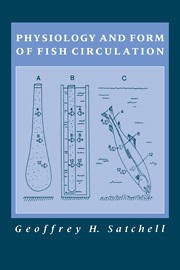Book contents
- Frontmatter
- Contents
- Preface
- 1 Introduction
- 2 The Heart
- 3 The peripheral circulation
- 4 The blood
- 5 Haemopoiesis and phagocytosis - the mononuclear phagocytic system
- 6 Circulation through special regions
- 7 Retial counter-current systems: flow–diffusion–concentration
- 8 Venous return and venous pumps
- 9 The autonomic nervous system
- 10 The response to exercise
- 11 The response to hypoxia
- 12 Myxine, a speculative conclusion
- References
- Appendix of popular and scientific names
- Index
11 - The response to hypoxia
Published online by Cambridge University Press: 05 February 2012
- Frontmatter
- Contents
- Preface
- 1 Introduction
- 2 The Heart
- 3 The peripheral circulation
- 4 The blood
- 5 Haemopoiesis and phagocytosis - the mononuclear phagocytic system
- 6 Circulation through special regions
- 7 Retial counter-current systems: flow–diffusion–concentration
- 8 Venous return and venous pumps
- 9 The autonomic nervous system
- 10 The response to exercise
- 11 The response to hypoxia
- 12 Myxine, a speculative conclusion
- References
- Appendix of popular and scientific names
- Index
Summary
Introduction
The proportion of oxygen in the atmosphere, relative to nitrogen is, in almost all circumstances, close to 21%, and hypoxia is a hazard encountered rarely, except by those air-breathing vertebrates which dwell in or fly at high altitudes or burrow beneath the ground. Fish, in contrast, may be subject to oxygen pressures that vary widely, from water which is supersaturated, with a PO 2 above 155 mm Hg, down to levels where oxygen is virtually absent. Photosynthesis by green algae and submerged aquatic plants may liberate oxygen into solution and cause hyperoxygenation; accumulations of organic material may, in their decay, take up much or all of the oxygen that would otherwise be available. The of shallow water in bays may decrease to 20 mm Hg by sunrise (Kerstens et al. 1979). Water from beneath winter ice, following the spring melt, often has a low oxygen content, as has water imprisoned below the thermocline. Even in normoxic water, ventilation may be temporarily impeded by eating and swallowing whole prey. Fish respond to these challenges with a variety of measures which maximize oxygen uptake and economize in its expenditure. We can group the changes that hypoxia evokes into three categories.
(1) Some are reflex responses set in train by the stimulation of oxygen receptors (Chapter 9). The increase in ventilation, the bradycardia of hypoxia, cardiorespiratory synchrony, and the constriction of peripheral blood vessels are examples which will need to be considered.
(2) There are intrinsic responses of the gill vessels, which bring about changes in the pattern of blood flow.
- Type
- Chapter
- Information
- Physiology and Form of Fish Circulation , pp. 170 - 182Publisher: Cambridge University PressPrint publication year: 1991



